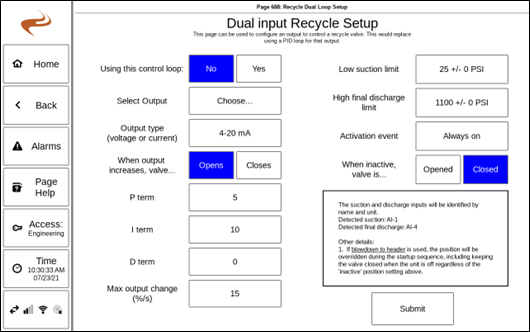Dual Recycle Setup: Difference between revisions
From EMIT Controls
No edit summary |
No edit summary |
||
| Line 10: | Line 10: | ||
[[File:Dual-recycle-setup.png]] | [[File:Dual-recycle-setup.png]] | ||
Some settings on this page: | |||
*'''Using this control loop''': Select Yes to use | |||
*'''Select output''': Pick the analog output that will connect to the valve. The normal Brain module has 4 analog outputs. | |||
*'''When output increases, valve...''': If driving 20mA makes the valve open, select "OPENS" otherwise select "CLOSES". If you are unsure, just select opens and come back later and flip it if the valve is running backwards. | |||
*'''P, I, D Term''': Set the PID terms. By default try P=5, I=5, D=0. Higher gains will react faster but can make the output more unstable. | |||
*'''Low suction limit''': Set a PSI setpoint for low suction. For example, if set to 10 PSI then when suction goes below 10 PSI the recycle will start to open. | |||
*'''High discharge limit''': Set a PSI setpoint for high discharge. | |||
*'''Activation Event''': If set to "Always Active", the loop will always run. Alternately the loop can be off while the unit is down and come on at some point during the start sequence and start controlling. | |||
*'''When inactive, valve is ...''': If the activation event is NOT "Always Active", then the valve will go to this position when the loop is not running. As a common example, the loop will be set to open when inactive (for startup) and then activate some number of seconds after load delay ends. | |||
Like a normal PID loop, a gauge for recycle can be added by navigating to “Settings” -> “Brain” -> “Gauges Setup”. Select a page, and in the “Other” category select “Special Recycle PID Status”. The gauge will show the current input and output status of the loop. | Like a normal PID loop, a gauge for recycle can be added by navigating to “Settings” -> “Brain” -> “Gauges Setup”. Select a page, and in the “Other” category select “Special Recycle PID Status”. The gauge will show the current input and output status of the loop. | ||
Latest revision as of 23:01, 29 January 2024
A recycle loop can be set up in one of two ways:
- As a normal PID loop using a single process input (suction OR discharge)
- As a dual input PID loop
If only needing one process input (e.g. suction), set the loop up as a normal PID loop except name the loop “RECYCLE” and set the setpoint accordingly.
If the recycle loop should use both discharge and suction to open, the special dual loop can be turned on. This is found at “Settings” -> “Brain” -> “Outputs Setup” -> “Recycle Dual Loop Setup”.
Some settings on this page:
- Using this control loop: Select Yes to use
- Select output: Pick the analog output that will connect to the valve. The normal Brain module has 4 analog outputs.
- When output increases, valve...: If driving 20mA makes the valve open, select "OPENS" otherwise select "CLOSES". If you are unsure, just select opens and come back later and flip it if the valve is running backwards.
- P, I, D Term: Set the PID terms. By default try P=5, I=5, D=0. Higher gains will react faster but can make the output more unstable.
- Low suction limit: Set a PSI setpoint for low suction. For example, if set to 10 PSI then when suction goes below 10 PSI the recycle will start to open.
- High discharge limit: Set a PSI setpoint for high discharge.
- Activation Event: If set to "Always Active", the loop will always run. Alternately the loop can be off while the unit is down and come on at some point during the start sequence and start controlling.
- When inactive, valve is ...: If the activation event is NOT "Always Active", then the valve will go to this position when the loop is not running. As a common example, the loop will be set to open when inactive (for startup) and then activate some number of seconds after load delay ends.
Like a normal PID loop, a gauge for recycle can be added by navigating to “Settings” -> “Brain” -> “Gauges Setup”. Select a page, and in the “Other” category select “Special Recycle PID Status”. The gauge will show the current input and output status of the loop.
